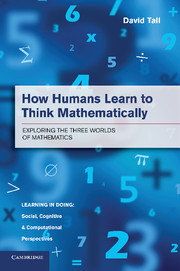Book contents
- Frontmatter
- Dedication
- Contents
- Series Foreword
- Journeys through three worlds of mathematics
- Preface
- Acknowledgements
- Illustration Credits
- I Prelude
- II School Mathematics and Its Consequences
- 2 The Foundations of Mathematical Thinking
- 3 Compression, Connection and Blending of Mathematical Ideas
- 4 Set-Befores, Met-Befores and Long-Term Learning
- 5 Mathematics and Emotion
- 6 The Three Worlds of Mathematics
- 7 Journeys through Embodiment and Symbolism
- 8 Problem Solving and Proof
- III Interlude
- IV University Mathematics and Beyond
- Appendix Where It All Came From
- References
- Index
8 - Problem Solving and Proof
from II - School Mathematics and Its Consequences
Published online by Cambridge University Press: 05 June 2014
- Frontmatter
- Dedication
- Contents
- Series Foreword
- Journeys through three worlds of mathematics
- Preface
- Acknowledgements
- Illustration Credits
- I Prelude
- II School Mathematics and Its Consequences
- 2 The Foundations of Mathematical Thinking
- 3 Compression, Connection and Blending of Mathematical Ideas
- 4 Set-Befores, Met-Befores and Long-Term Learning
- 5 Mathematics and Emotion
- 6 The Three Worlds of Mathematics
- 7 Journeys through Embodiment and Symbolism
- 8 Problem Solving and Proof
- III Interlude
- IV University Mathematics and Beyond
- Appendix Where It All Came From
- References
- Index
Summary
So far in this book we have considered the building of knowledge structures over the long term as mathematical thinking becomes more sophisticated. At any stage the individual may meet a situation that does not appear to have an available method of solution. The activity that the individual pursues to reach a solution is termed problem solving.
The immediate problem is to characterize the meaning of ‘problem solving’. In many traditional curricula it means a sequence of exercises following a new piece of learning, starting with simple reproduction of learnt procedures and then shifting to slightly more complicated situations that require more than a simple reproduction of a learned algorithm.
Many curricula speak of ‘word problems’, meaning problems involvingsimple arithmetic that are formulated in words, such as ‘if Mary has three more apples than John and Mary has five apples, how many apples does John have?’ Here the arithmetic is simple: Mary has five and John has three less, which is two. However, cue words such as ‘three’ and ‘more’ in a moderately complicated sentence lead some children to respond with the incorrect solution ‘eight’. Hence, for some children, this question is a problem.
- Type
- Chapter
- Information
- How Humans Learn to Think MathematicallyExploring the Three Worlds of Mathematics, pp. 175 - 212Publisher: Cambridge University PressPrint publication year: 2013



